
Safety and security company Federal Signal (NYSE:FSS) beat Wall Street’s revenue expectations in Q3 CY2025, with sales up 17% year on year to $555 million. The company expects the full year’s revenue to be around $2.12 billion, close to analysts’ estimates. Its non-GAAP profit of $1.14 per share was 5.6% above analysts’ consensus estimates.
Is now the time to buy Federal Signal? Find out by accessing our full research report, it’s free for active Edge members.
Federal Signal (FSS) Q3 CY2025 Highlights:
- Revenue: $555 million vs analyst estimates of $544.8 million (17% year-on-year growth, 1.9% beat)
- Adjusted EPS: $1.14 vs analyst estimates of $1.08 (5.6% beat)
- Adjusted EBITDA: $116.2 million vs analyst estimates of $112.7 million (20.9% margin, 3.1% beat)
- The company slightly lifted its revenue guidance for the full year to $2.12 billion at the midpoint from $2.1 billion
- Management raised its full-year Adjusted EPS guidance to $4.13 at the midpoint, a 3% increase
- Operating Margin: 16.9%, in line with the same quarter last year
- Free Cash Flow Margin: 9.7%, down from 12.8% in the same quarter last year
- Backlog: $992 million at quarter end, down 4% year on year (<1% beat)
- Market Capitalization: $7.89 billion
"Our businesses were able to deliver 17% year-over-year net sales growth, double-digit operating income improvement, and a 130-basis point increase in adjusted EBITDA margin during the third quarter," commented Jennifer L. Sherman, President and Chief Executive Officer.
Company Overview
Developing sirens that warned of air raid attacks or fallout during the Cold War, Federal Signal (NYSE:FSS) provides safety and emergency equipment for government agencies, municipalities, and industrial companies.
Revenue Growth
Examining a company’s long-term performance can provide clues about its quality. Any business can put up a good quarter or two, but many enduring ones grow for years. Thankfully, Federal Signal’s 12.3% annualized revenue growth over the last five years was excellent. Its growth surpassed the average industrials company and shows its offerings resonate with customers, a great starting point for our analysis.
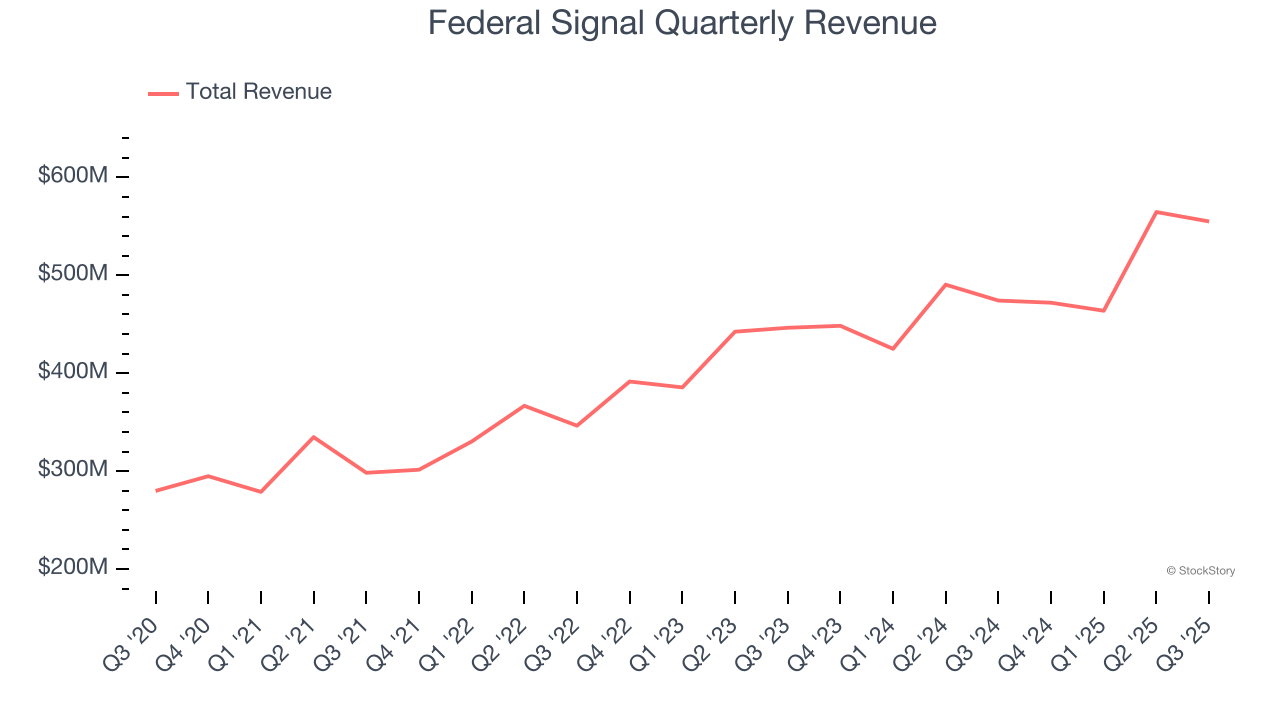
We at StockStory place the most emphasis on long-term growth, but within industrials, a half-decade historical view may miss cycles, industry trends, or a company capitalizing on catalysts such as a new contract win or a successful product line. Federal Signal’s annualized revenue growth of 11.1% over the last two years is below its five-year trend, but we still think the results suggest healthy demand. Federal Signal’s recent performance shows it’s one of the better Heavy Transportation Equipment businesses as many of its peers faced declining sales because of cyclical headwinds. 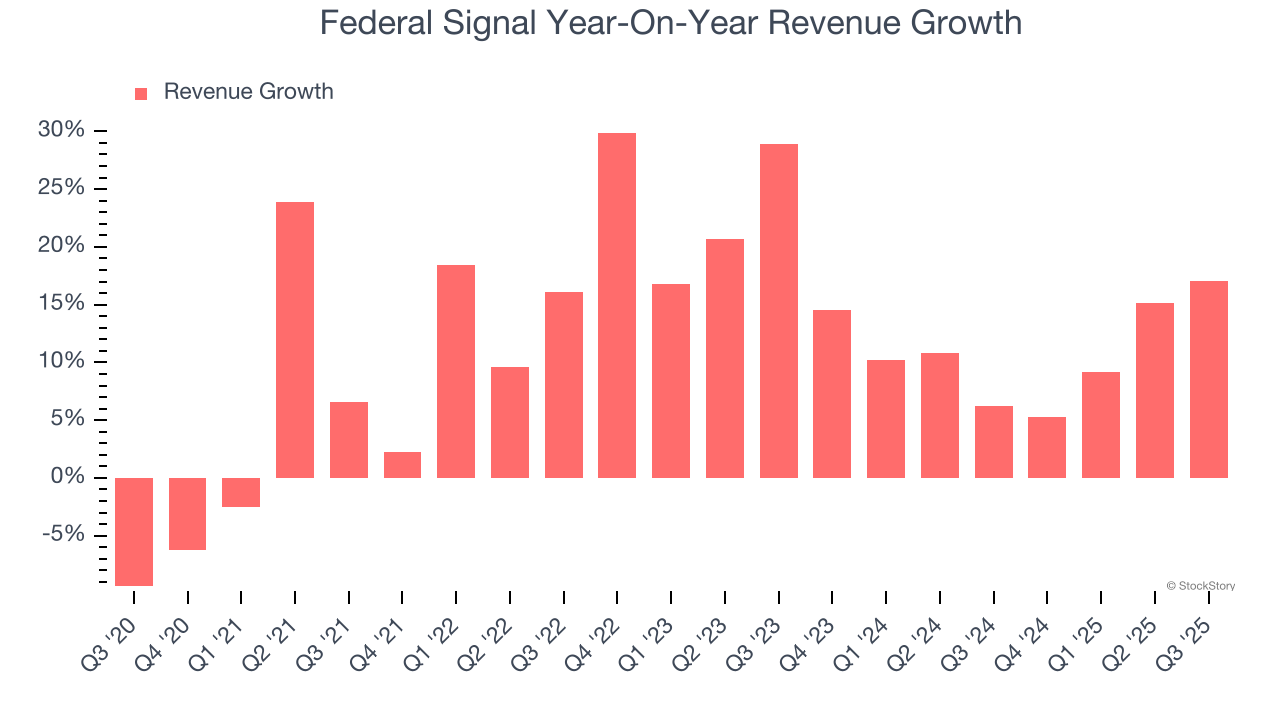
Federal Signal also reports its backlog, or the value of its outstanding orders that have not yet been executed or delivered. Federal Signal’s backlog reached $992 million in the latest quarter and averaged 4.3% year-on-year growth over the last two years. Because this number is lower than its revenue growth, we can see the company fulfilled orders at a faster rate than it added new orders to the backlog. This implies Federal Signal was operating efficiently but raises questions about the health of its sales pipeline. 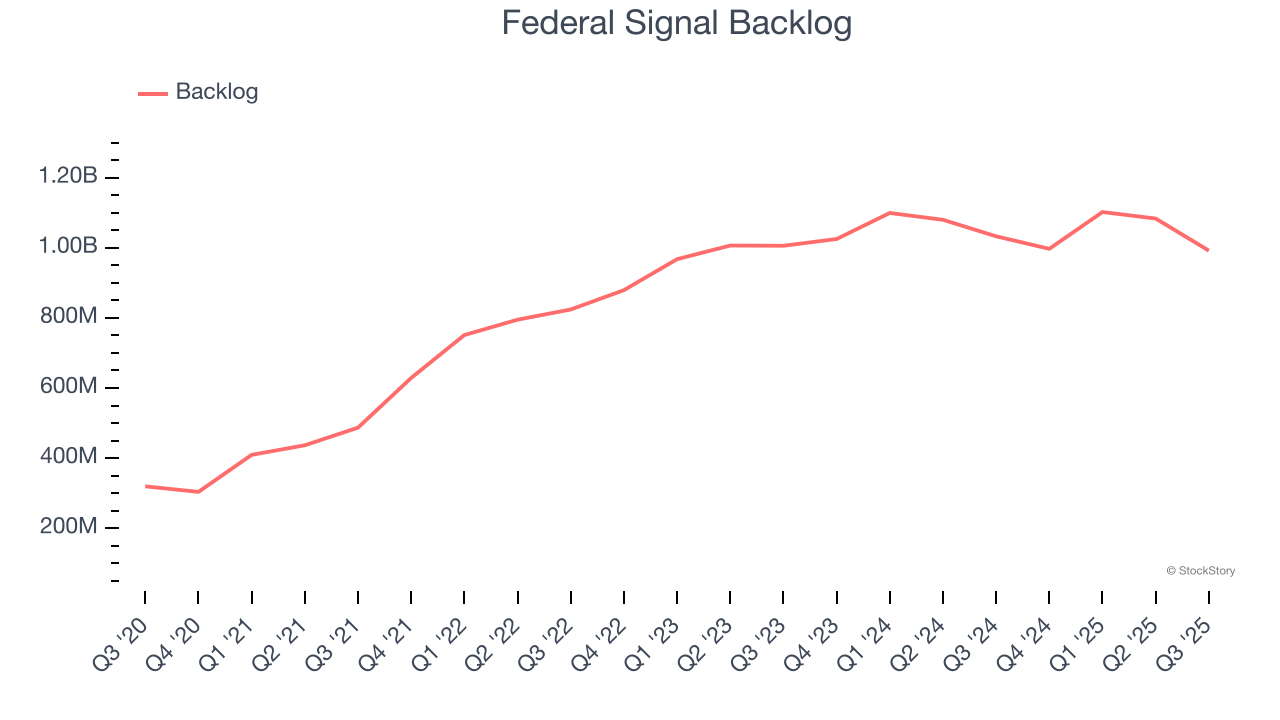
This quarter, Federal Signal reported year-on-year revenue growth of 17%, and its $555 million of revenue exceeded Wall Street’s estimates by 1.9%.
Looking ahead, sell-side analysts expect revenue to grow 11.1% over the next 12 months, similar to its two-year rate. This projection is admirable and suggests the market is forecasting success for its products and services.
Here at StockStory, we certainly understand the potential of thematic investing. Diverse winners from Microsoft (MSFT) to Alphabet (GOOG), Coca-Cola (KO) to Monster Beverage (MNST) could all have been identified as promising growth stories with a megatrend driving the growth. So, in that spirit, we’ve identified a relatively under-the-radar profitable growth stock benefiting from the rise of AI, available to you FREE via this link.
Operating Margin
Federal Signal has been an efficient company over the last five years. It was one of the more profitable businesses in the industrials sector, boasting an average operating margin of 13.4%. This result was particularly impressive because of its low gross margin, which is mostly a factor of what it sells and takes huge shifts to move meaningfully. Companies have more control over their operating margins, and it’s a show of well-managed operations if they’re high when gross margins are low.
Analyzing the trend in its profitability, Federal Signal’s operating margin rose by 4.8 percentage points over the last five years, as its sales growth gave it operating leverage.
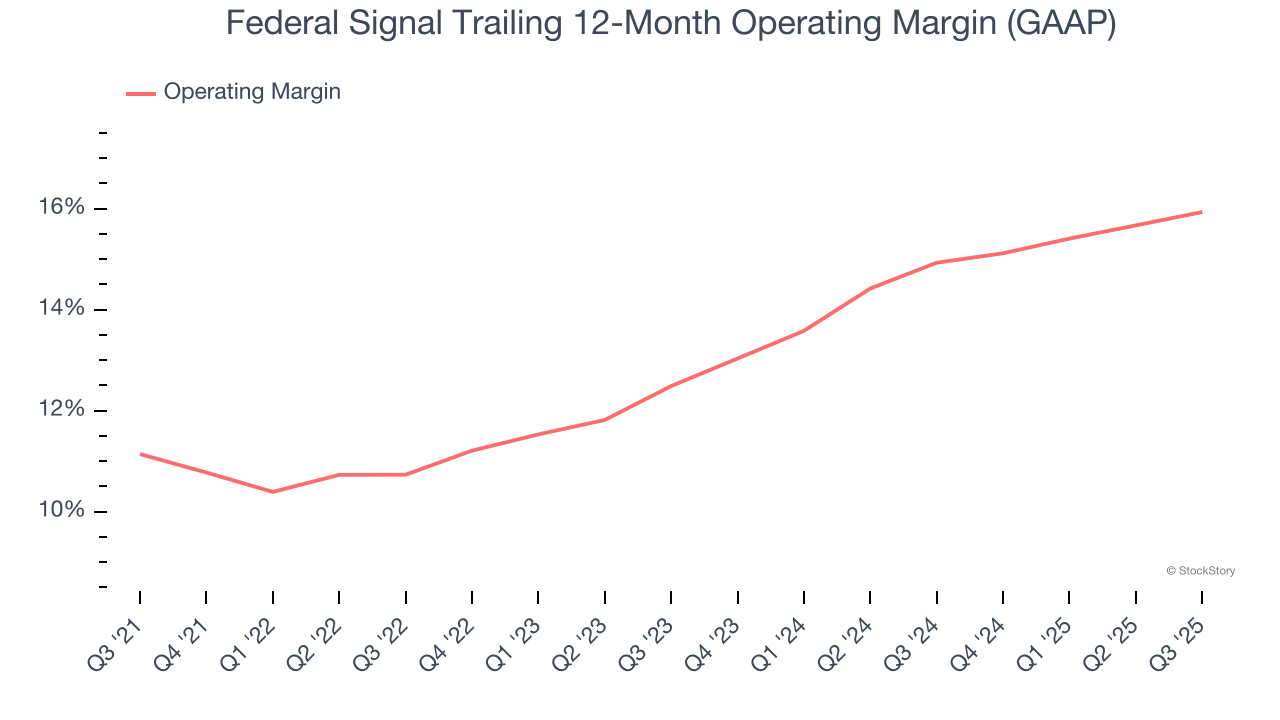
This quarter, Federal Signal generated an operating margin profit margin of 16.9%, in line with the same quarter last year. This indicates the company’s cost structure has recently been stable.
Earnings Per Share
Revenue trends explain a company’s historical growth, but the long-term change in earnings per share (EPS) points to the profitability of that growth – for example, a company could inflate its sales through excessive spending on advertising and promotions.
Federal Signal’s EPS grew at an astounding 18.2% compounded annual growth rate over the last five years, higher than its 12.3% annualized revenue growth. This tells us the company became more profitable on a per-share basis as it expanded.
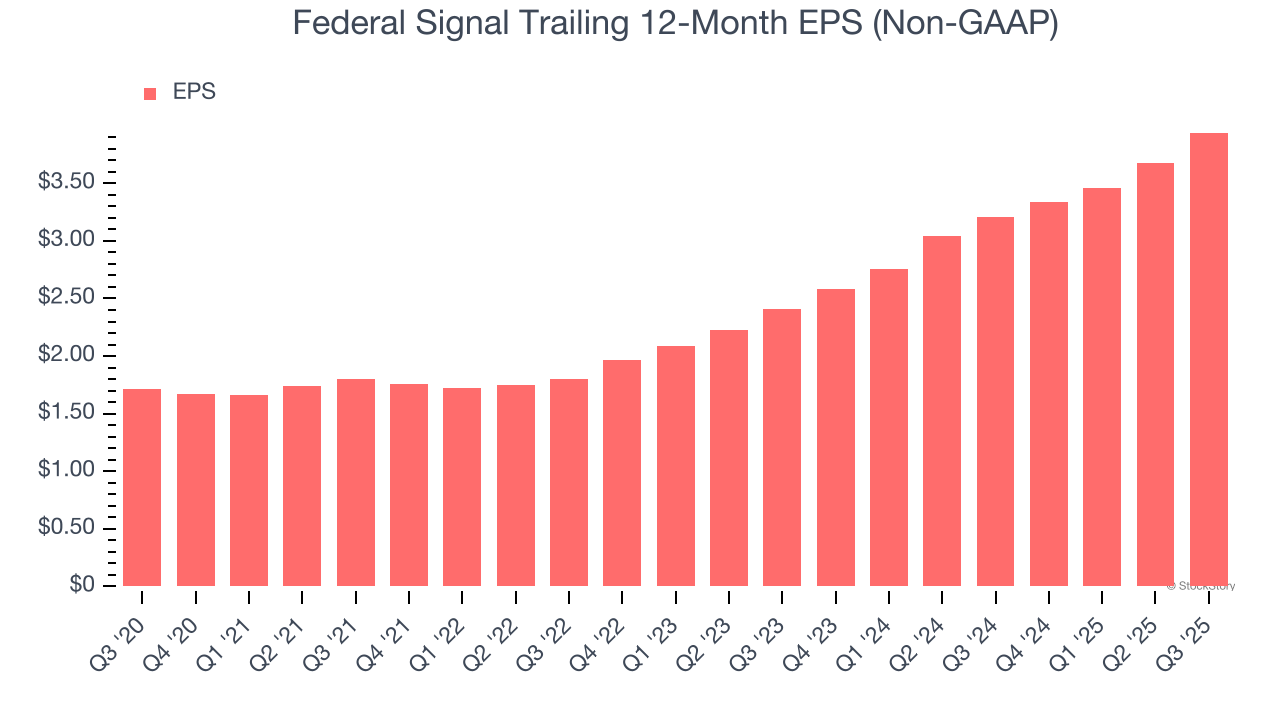
We can take a deeper look into Federal Signal’s earnings quality to better understand the drivers of its performance. As we mentioned earlier, Federal Signal’s operating margin was flat this quarter but expanded by 4.8 percentage points over the last five years. This was the most relevant factor (aside from the revenue impact) behind its higher earnings; interest expenses and taxes can also affect EPS but don’t tell us as much about a company’s fundamentals.
Like with revenue, we analyze EPS over a more recent period because it can provide insight into an emerging theme or development for the business.
For Federal Signal, its two-year annual EPS growth of 27.9% was higher than its five-year trend. We love it when earnings growth accelerates, especially when it accelerates off an already high base.
In Q3, Federal Signal reported adjusted EPS of $1.14, up from $0.88 in the same quarter last year. This print beat analysts’ estimates by 5.6%. Over the next 12 months, Wall Street expects Federal Signal’s full-year EPS of $3.94 to grow 12.5%.
Key Takeaways from Federal Signal’s Q3 Results
Revenue, EBITDA, and EPS all beat Wall Street’s estimates in the quarter. It was also good to see Federal Signal’s backlog come in slightly better than Consensus. Additionally, full-year EPS guidance top analysts’ expectations. Overall, we think this was a solid quarter with some key areas of upside. Investors were likely hoping for more, and shares traded down 6.7% to $121.19 immediately after reporting.
Is Federal Signal an attractive investment opportunity right now? The latest quarter does matter, but not nearly as much as longer-term fundamentals and valuation, when deciding if the stock is a buy. We cover that in our actionable full research report which you can read here, it’s free for active Edge members.
